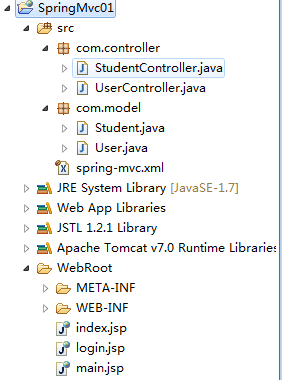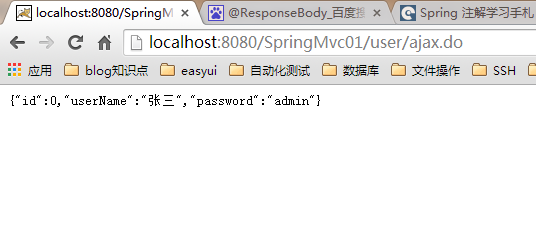先来看看一个简单的用户登录Demo:
工程目录结构:
User类实体:
package com.model;
public class User {
private int id;
private String userName;
private String password;
public User() {
super();
}
public User(String userName, String password) {
super();
this.userName = userName;
this.password = password;
}
public int getId() {
return id;
}
public void setId(int id) {
this.id = id;
}
public String getUserName() {
return userName;
}
public void setUserName(String userName) {
this.userName = userName;
}
public String getPassword() {
return password;
}
public void setPassword(String password) {
this.password = password;
}
}
web.xml配置文件:
<?xml version="1.0" encoding="UTF-8"?>
<web-app xmlns:xsi="http://www.w3.org/2001/XMLSchema-instance"
xmlns="http://java.sun.com/xml/ns/javaee"
xsi:schemaLocation="http://java.sun.com/xml/ns/javaee http://java.sun.com/xml/ns/javaee/web-app_3_0.xsd"
id="WebApp_ID" version="3.0">
<display-name>SpringMvc</display-name>
<welcome-file-list>
<welcome-file>index.jsp</welcome-file>
</welcome-file-list>
<servlet>
<servlet-name>springMVC</servlet-name>
<servlet-class>org.springframework.web.servlet.DispatcherServlet</servlet-class>
<init-param>
<param-name>contextConfigLocation</param-name>
<param-value>classpath:spring-mvc.xml</param-value>
</init-param>
<load-on-startup>1</load-on-startup>
</servlet>
<servlet-mapping>
<servlet-name>springMVC</servlet-name>
<url-pattern>*.do</url-pattern>
</servlet-mapping>
<filter>
<filter-name>characterEncodingFilter</filter-name>
<filter-class>org.springframework.web.filter.CharacterEncodingFilter</filter-class>
<init-param>
<param-name>encoding</param-name>
<param-value>utf-8</param-value>
</init-param>
<init-param>
<param-name>forceEncoding</param-name>
<param-value>true</param-value>
</init-param>
</filter>
<filter-mapping>
<filter-name>characterEncodingFilter</filter-name>
<url-pattern>*.do</url-pattern>
</filter-mapping>
</web-app> 主要是添加了一个characterEncodingFilter过滤器,对任意*.do的url资源的请求体进行utf-8编码。
Spring中的characterEncodingFilter过滤器能很好的帮我们解决项目中的中文乱码问题。使用方法同上,这里的设置只是应用于请求体中的中文乱码解决,非请求参数中的中文乱码解决。
作用是,当forceEncoding为false的前提下(默认为false),当request没有指定content-type或content-type不含编码时,该filter将会为这个request设定请求体的编码为filter的encoding值。
spring-mvc.xml配置文件:
<?xml version="1.0" encoding="UTF-8"?>
<beans xmlns="http://www.springframework.org/schema/beans"
xmlns:xsi="http://www.w3.org/2001/XMLSchema-instance"
xmlns:p="http://www.springframework.org/schema/p"
xmlns:context="http://www.springframework.org/schema/context"
xmlns:mvc="http://www.springframework.org/schema/mvc"
xsi:schemaLocation="
http://www.springframework.org/schema/beans
http://www.springframework.org/schema/beans/spring-beans.xsd
http://www.springframework.org/schema/mvc
http://www.springframework.org/schema/mvc/spring-mvc.xsd
http://www.springframework.org/schema/context
http://www.springframework.org/schema/context/spring-context.xsd">
<!-- 加载注解驱动 -->
<mvc:annotation-driven />
<!-- 使用注解的包,包括子集 -->
<context:component-scan base-package="com.controller"/>
<context:component-scan base-package="com.model"/>
<!-- 配置视图解析器 -->
<bean id="viewResolver" class="org.springframework.web.servlet.view.InternalResourceViewResolver">
<property name="prefix" value="/WEB-INF/jsp/"/>
<property name="suffix" value=".jsp"/>
</bean>
</beans>再来看看前台login.jsp页面,就是一个登录表单:
<%@ page language="java" import="java.util.*" pageEncoding="UTF-8"%>
<%
String path = request.getContextPath();
String basePath = request.getScheme()+"://"+request.getServerName()+":"+request.getServerPort()+path+"/";
%>
<!DOCTYPE HTML PUBLIC "-//W3C//DTD HTML 4.01 Transitional//EN">
<html>
<head>
<base href="<%=basePath%>">
<title>My JSP 'login.jsp' starting page</title>
<meta http-equiv="pragma" content="no-cache">
<meta http-equiv="cache-control" content="no-cache">
<meta http-equiv="expires" content="0">
<meta http-equiv="keywords" content="keyword1,keyword2,keyword3">
<meta http-equiv="description" content="This is my page">
<!--
<link rel="stylesheet" type="text/css" href="styles.css">
-->
</head>
<body>
<form action="${pageContext.request.contextPath }/user/login.do" method="post">
<table align="center">
<tr>
<td>用户名:</td>
<td><input type="text" name="userName"></td>
</tr>
<tr>
<td>密码:</td>
<td><input type="password" name="password"></td>
</tr>
<tr>
<td>
<input type="submit" value="登录">
</td>
</tr>
</table>
</form>
</body>
</html>
效果如下:
这里请求的url为项目下的/user/login.do资源,再来看看具体的url实现:
package com.controller;
import javax.servlet.http.Cookie;
import javax.servlet.http.HttpServletRequest;
import javax.servlet.http.HttpServletResponse;
import javax.servlet.http.HttpSession;
import org.springframework.stereotype.Controller;
import org.springframework.web.bind.annotation.RequestMapping;
import org.springframework.web.bind.annotation.ResponseBody;
import com.model.User;
@Controller
@RequestMapping("/user")
public class UserController {
@RequestMapping("/login")
public String login(HttpServletRequest request,HttpServletResponse response){
System.out.println("---------登录验证--------");
String userName = request.getParameter("userName");
String password = request.getParameter("password");
Cookie cookie = new Cookie("user", userName+"-"+password);
User currentUser = new User(userName, password);
cookie.setMaxAge(1*60*60*24*7);
response.addCookie(cookie);
HttpSession session = request.getSession();
session.setAttribute("currentUser", currentUser);
return "redirect:/main.jsp";
}
} 这里使用@Controller注解声明一个控制器,使用@RequestMapping("/user")声明该控制器的url为project下的/user。在使用@RequestMapping("/login")声明类下的login方法的访问详细url为/user/login.do。
程序中主要是获取前台提交的userName、password参数值封装至cookie和session中,再通过return "redirect:/main.jsp"直接通过Spring MVC重定向到main.jsp文件。
再来看看main.jsp文件:
<%@ page language="java" import="java.util.*" pageEncoding="UTF-8"%>
<%
String path = request.getContextPath();
String basePath = request.getScheme()+"://"+request.getServerName()+":"+request.getServerPort()+path+"/";
%>
<!DOCTYPE HTML PUBLIC "-//W3C//DTD HTML 4.01 Transitional//EN">
<html>
<head>
<base href="<%=basePath%>">
<title>My JSP 'login.jsp' starting page</title>
<meta http-equiv="pragma" content="no-cache">
<meta http-equiv="cache-control" content="no-cache">
<meta http-equiv="expires" content="0">
<meta http-equiv="keywords" content="keyword1,keyword2,keyword3">
<meta http-equiv="description" content="This is my page">
<!--
<link rel="stylesheet" type="text/css" href="styles.css">
-->
</head>
<body>
您好,${currentUser.userName }
</body>
</html>
这里直接输出登录的用户名,登录成功页面如下:
再来顺便看看Spring直接返回json数据的一个小Demo,前台界面很简单,只有一个href链接,请求路径为user/ajax.do。具体如下:
<%@ page language="java" import="java.util.*" pageEncoding="UTF-8"%>
<%
String path = request.getContextPath();
String basePath = request.getScheme()+"://"+request.getServerName()+":"+request.getServerPort()+path+"/";
%>
<!DOCTYPE HTML PUBLIC "-//W3C//DTD HTML 4.01 Transitional//EN">
<html>
<head>
<base href="<%=basePath%>">
<title>My JSP 'login.jsp' starting page</title>
<meta http-equiv="pragma" content="no-cache">
<meta http-equiv="cache-control" content="no-cache">
<meta http-equiv="expires" content="0">
<meta http-equiv="keywords" content="keyword1,keyword2,keyword3">
<meta http-equiv="description" content="This is my page">
<!--
<link rel="stylesheet" type="text/css" href="styles.css">
-->
</head>
<body>
<a href="user/ajax.do">测试ajax</a>
</body>
</html>
后台具体实现:
package com.controller;
import javax.servlet.http.Cookie;
import javax.servlet.http.HttpServletRequest;
import javax.servlet.http.HttpServletResponse;
import javax.servlet.http.HttpSession;
import org.springframework.stereotype.Controller;
import org.springframework.web.bind.annotation.RequestMapping;
import org.springframework.web.bind.annotation.ResponseBody;
import com.model.User;
@Controller
@RequestMapping("/user")
public class UserController {
@RequestMapping("/ajax")
public @ResponseBody User ajax(){
User user = new User("张三", "admin");
return user;
}
} 通过@ResponseBody注解,使得由Spring完成对象、协议的转换,可以讲指定的对象转换成指定协议的数据。加上@ResponseBody后,会直接返回json数据。效果如下:
这里可以看出返回的user对象的json格式数据,完成了后台对象到json的转换。仅仅通过Spring的一句注解轻松实现。



























 340
340

 被折叠的 条评论
为什么被折叠?
被折叠的 条评论
为什么被折叠?








